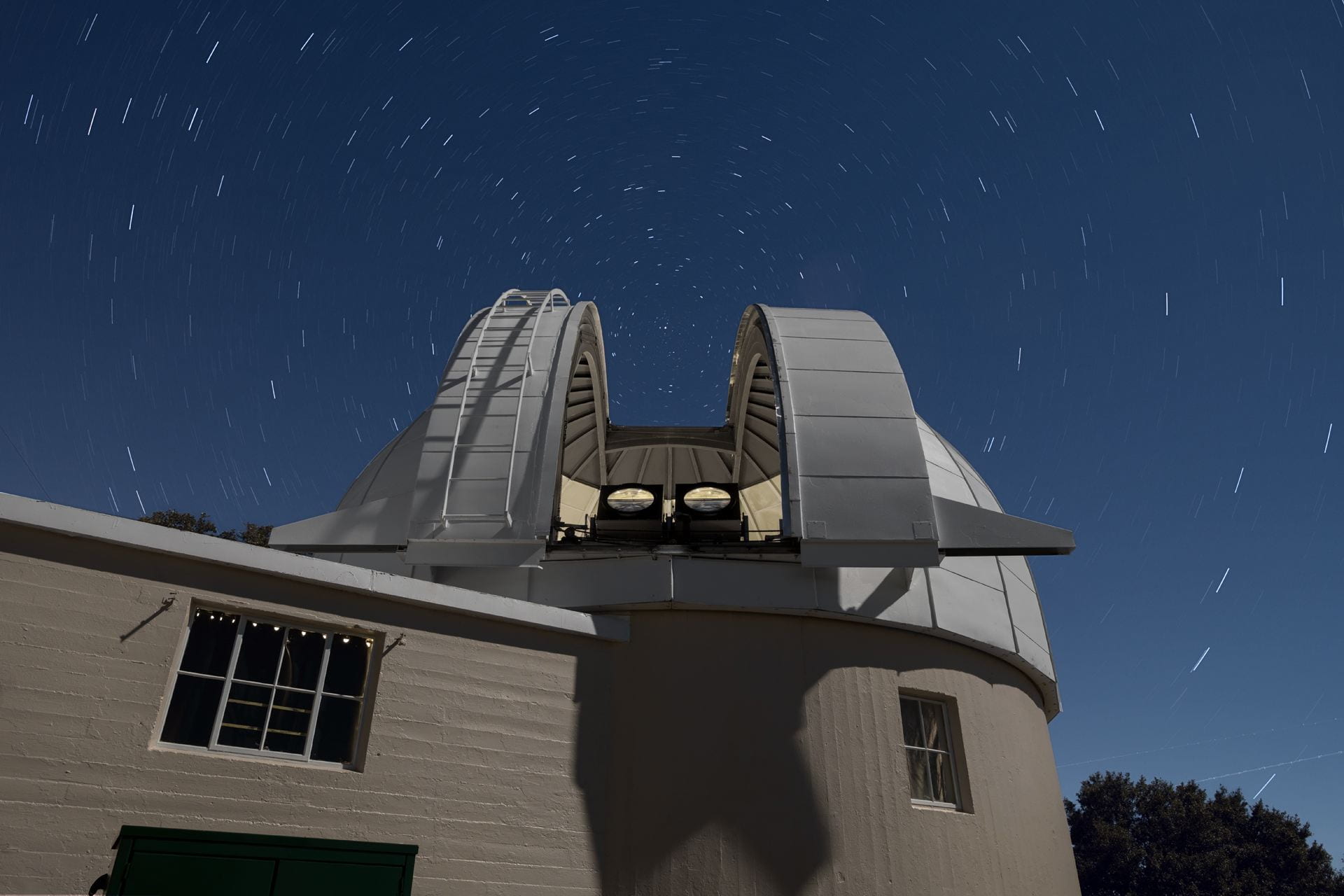Two, first-of-a-kind telescopes poised to collectively image the entire observable sky in the current search for extraterrestrial intelligence (SETI) are now installed in the Astrograph Dome at Lick Observatory. These novel devices, part of a planned collection of large lenses, could help researchers on project Panoramic SETI (PANOSETI) discover new astronomical phenomena or signals from deep space.
Lick Observatory is owned and operated by the University of California Observatories (UCO) for the benefit of astronomers across the UC system. UC San Diego Associate Professor and UCO Advisory Committee Chair Shelley Wright has been designing and working to build PANOSETI as one of the first dedicated optical and near-infrared SETI facilities.
“The refurbishment of the Astrograph Dome is truly remarkable. Thanks to the entire Lick staff for aiding with all of our engineering needs and for the incredible hospitality while staying on Mount Hamilton,” Wright said. “Both PANOSETI telescopes are functioning successfully, and the astrograph remote configuration and health of the instruments are behaving well.”
According to project researchers from UC San Diego, UC Berkeley, University of California Observatories and Harvard University, PANOSETI is the first of its kind, dedicated telescope collection capable of searching for fast-time domain signals. These are pulsed signals occurring between nanosecond-to-second time scales—either from an artificial origin (e.g., ETI communication) or an astrophysical phenomena (e.g., counterparts to fast-radio bursts).
“We are thrilled to see the history of cutting-edge research continued by UC astronomers using Lick Observatory. The Double Astrograph at Lick Observatory was a photographic survey of the northern sky begun in 1941 using two side-by-side refracting telescopes. Nearly 80 years later Shelley’s team is installing multiple side-by-side refracting telescopes into the same Astrograph Dome for a new survey. The similarities are striking: multiple telescopes of a similar size, large field of view and survey of the northern sky looking for both distant and nearby sources,” said Matthew Shetrone, deputy director of UCO.
PANOSETI’s final design will have 80 telescopes per observatory and two locations. Site selection is underway, and the research team hopes to begin observatory construction and production in the next year.
“The deployment of two PANOSETI telescopes now offers us a new window into how the universe behaves at nanosecond timescales,” said Wright. “Our entire team is incredibly excited to embark on this new phase of our ambitious program.”
First developed in 2018, the project’s aim is to create a dedicated optical SETI observatory to image the entire observable sky—approximately 10,000 square degrees—instantaneously. The final project plans to generate hundreds of telescopes to achieve this enormous sky coverage. What distinguishes the program is that a single PANOSETI telescope images 10 degrees by 10 degrees—for reference, the Earth’s moon measures one-half degree in size. Currently, the team is characterizing the night sky and continuing to develop its large observatory mission.
“PANOSETI explores the universe at billionth-of-a-second time scales, a time scale that Earthlings have not examined well,” said Dan Werthimer, chief technologist at UC Berkeley’s SETI Research Center and co-investigator. “When astronomers examine an unexplored parameter space, they usually find something surprising that no one predicted. PANOSETI could discover new astronomical phenomena or signals from E.T.”
This initial pair of PANOSETI telescopes marks a critical milestone for testing the system and making one-of-one kind observations, enabling new discoveries of astrophysical transient and variable phenomena. With support from the Lick Observatory staff, the UC San Diego and UC Berkeley researchers can operate these first SETI-dedicated telescopes and the Astrograph Dome from their campus locations.
The full research team includes: Shelley Wright (PI), Maren Cosens, Aaron Brown, Jérôme Maire and James Wiley from UC San Diego; Dan Werthimer, Ryan Lee, Wei Liu, Andrew Siemon and Samuel Chaim-Weismann from UC Berkeley; Paul Horowitz and Avinash Uttamchandani from Harvard; Frank Drake, SETI Institute; Andrew Howard, Caltech; Remington Stone, Lick Observatory; Franklin Antonio, Qualcomm; Michael Aronson, Electronic Packaging Man; Richard Treffers, Starman Systems and Rick Raffanti, Techné Instruments.
The PANOSETI research and instrumentation program was made possible by the support and interest of Franklin Antonio The Bloomfield Family Foundation (SETI research at UC San Diego in the CASS Optical and Infrared Laboratory); NSF ([grant 1407804] UC Berkeley SETI efforts involved with PANOSETI), the Breakthrough Prize Foundation (UC Berkeley), and the Marilyn and Watson Alberts SETI Chair fund (UC Berkeley) and The Planetary Society (Harvard SETI). The Lick Astrograph was refurbished with gifts from Robert W. Sieker and the Rust-Oleum Corporation.
Panoramic SETI (PANOSETI) will utilize a configuration of many SETI telescopes to allow simultaneous monitoring of the entire observable sky, when weather permits. The program aims to discover very brief optical pulses that may arise either from astrophysical sources or extraterrestrial communication (“technosignatures”). Photo by © Laurie Hatch.

